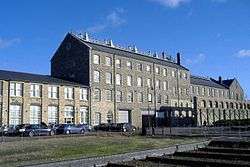Historic England
 | |
| Formation | 1 April 2015 |
|---|---|
| Legal status | Non-departmental public body |
| Headquarters | The Engine House, Firefly Avenue, Swindon, Wiltshire SN2 2EH |
Region served | England |
Leadership |
Duncan Wilson (chief executive) |
Budget | £88.5 million[1] |
| Website |
historicengland |
Historic England (officially the Historic Buildings and Monuments Commission for England) is an executive non-departmental public body of the British Government sponsored by the Department for Culture, Media and Sport (DCMS). It is tasked with protecting the historical environment of England by preserving and listing historic buildings, ancient monuments and advising central and local government.
The body was officially created by the National Heritage Act 1983, and operated from April 1984 to April 2015 under the name of English Heritage.[2] In 2015, following the changes to English Heritage's structure that moved the protection of the National Heritage Collection into the voluntary sector in the English Heritage Trust, the body that remained was rebranded as Historic England.[3] Historic England has a similar remit to and complements the work of Natural England which aims to protect the natural environment.
The body also inherited the Historic England Archive from the old English Heritage, and projects linked to the archive such as Britain from Above, which saw the archive work with the Royal Commission on the Ancient and Historical Monuments of Wales and the Royal Commission on the Ancient and Historical Monuments of Scotland to digitise, catalogue and put online 96,000 of the oldest Aerofilms images. The archive also holds various nationally important collections and the results of older projects such as the work of the National Buildings Record, later absorbed by the Royal Commission on the Historical Monuments of England and the Images of England project which set out to create a freely accessible online database of the 370,000 listed properties in England at a snapshot in time at the turn of the millennium.
Remit


Historic England inherits English Heritage's position as the UK government's statutory adviser and a statutory consultee on all aspects of the historic environment and its heritage assets.[4] This includes archaeology on land and under water, historic buildings sites and areas, designated landscapes and the historic elements of the wider landscape.[5] It monitors and reports on the state of England's heritage and publishes the annual Heritage at Risk survey which is one of the UK Government's Official statistics. It is tasked to secure the preservation and enhancement of the man-made heritage of England for the benefit of future generations.[5]
Its remit involves:
- Caring for nationally important archive collections of photographs, drawings and other records which document the historic environment of England and date from the eighteenth century onwards.
- Giving grants national and local organisations for the conservation of historic buildings, monuments and landscapes. In 2013/14 over £13 million worth of grants were made to support heritage buildings.[6]
- Advising central UK government on which English heritage assets are nationally important and should be protected by designation (i.e. listing, scheduling etc.).[7][8]
- Administering and maintaining the register of England's listed buildings, scheduled monuments, registered battlefields, World Heritage Sites and protected parks and gardens.[9] This is published as an online resource as 'The National Heritage List for England'.
- Advising local authorities on managing changes to the most important parts of heritage.
- Providing expertise through advice, training and guidance to improve the standards and skills of people working in heritage, practical conservation and access to resources. In 2009–2010 it trained around 200 professionals working in local authorities and the wider sector.[6]
- Consulting and collaborating with other heritage bodies, local and national planning organisations e.g. the preparation of Planning Policy statement for the Historic Environment (PPS5)[10]
- Commissioning and conducting archaeological research, including the publication of 'Heritage Counts' and ‘Heritage at Risk’ on behalf of the heritage sector which are the annual research surveys into the state of England's heritage.
It is not responsible for approving alterations to listed buildings. The management of listed buildings is the responsibility of local planning authorities and the Department for Communities and Local Government.[10]
It also owns the National Heritage Collection of nationally important historic sites, currently in public care. However they do not run these sites as this function is instead carried out by the English Heritage Trust under licence until 2023.[11]
See also
- English Heritage
- Historic England Archive
- Cadw
- Historic Scotland
- Northern Ireland Environment Agency
- Manx National Heritage
- Department for Culture, Media and Sport
- Conservation in the United Kingdom
- Heritage Open Days
- List of Conservation topics
- List of heritage registers
- List of museums in England
- Heritage film
References
- ↑ "How We Are Funded". Historic England. Historic England. Retrieved 6 April 2015.
- ↑ "Historic England's Role". Historic England. Historic England. Retrieved 6 April 2015.
- ↑ "New Era for England's Heritage". English Heritage. English Heritage. Retrieved 6 April 2015.
- ↑ "Historic Environment". Retrieved 16 May 2011.
- 1 2 "Funding of the Arts and Heritage". Retrieved 16 May 2011.
- 1 2 "English Heritage Annual Report and Accounts". Historic England. English Heritage. Archived from the original on 13 April 2015. Retrieved 6 April 2015.
- ↑ "Ancient Monuments and Archaeological Areas Act 1979". Retrieved 16 May 2011.
- ↑ "National Heritage Act 1983, Historic Buildings and Monuments Commission for England". Retrieved 16 May 2011.
- ↑ "Planning (Listed Buildings and Conservation Areas) Act 1990". Retrieved 16 May 2011.
- 1 2 "Planning Policy Statement 5: Planning for the Historic Environment". Archived from the original on 18 January 2017. Retrieved 16 May 2011.
- ↑ "Historic England and the English Heritage Trust". Historic England. Historic England. Retrieved 6 April 2015.
External links
| Wikimedia Commons has media related to Historic England. |
- Official website
- The Historic England Archive: Search over 1 million catalogue entries describing photographs, plans and drawings of England's buildings and historic sites, held in the Historic England Archive.
- Britain from Above : presents the unique Aerofilms collection of aerial photographs from 1919-1953.
- Images of England website
- Heritage Explorer: Education site for teachers
- Department for Culture Media and Sport